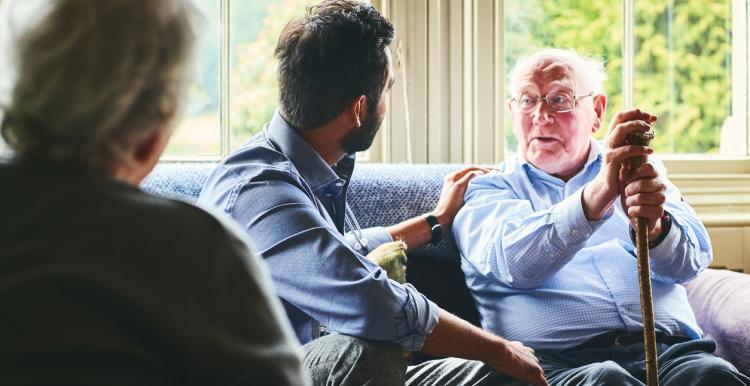COVID-19: What you need to know when visiting a care home

Last updated 02/12/2020
New government guidance recognises how important it is to allow care home residents to safely meet their loved ones.
Whilst preventing infections and protecting staff and residents remains a priority, new guidance sets out arrangements for visitor testing along with other infection control measures, allowing for safe, meaningful visits by Christmas.
Can I visit someone in a care home?
Each care home is responsible for setting the visiting policy in that home.
Indoor ‘end of life’ visits should always be enabled. ‘End of life’ is defined as “those who are in their last year of life”.
The new guidance also sets out steps for homes to allow indoor and outdoor visits for other residents too.
For homes allowing indoor visits, visitors will be tested on arrival to the home. Any visitor with a negative test will be provided with Personal Protective Equipment (PPE) to enter the home for their visit.
Please check with the care home manager about tests and visits in your local home.
Go to full guidance
For the most up to date guidance, including information of what should be included in your care home’s visiting policy, visit the Gov.uk website.
See also the guidance for supported living settings.
How do I get a test to visit my loved one in a care home?
The Department of Health and Social Care are providing all CQC-registered care homes in England with rapid tests. Tests will be rolled out from 2 December and should be available in all homes by 25 December.
Indoor visits will only be able to take place once care homes receive their tests from the Department of Health and Social Care. Care homes will then supply visitors with a test on the day of their visit.
When arriving at a home, staff will test visitors using a Lateral Flow Device (LFD). These LFD tests will involve taking a throat and nasal swab sample, after which, visitors will receive their results within 20-30 mins. During this time, visitors must follow policies as set out by the care home (i.e. stay in designated waiting spaces) and not enter the home until they receive a negative test result and are provided with PPE.
If visitors test positive using an LFD test at the home, they will be offered a second COVID-19 test which will be able to confirm whether an infection is present. Results should be available from these confirmatory tests within 48-72 hours.
The care home you are visiting should provide you with full details about tests and visits, including how negative / positive results will be registered.
What should I do to keep the person I am visiting safe?
Visitors should wash their hands for 20 seconds using soap and hot water or use hand sanitiser on entering and leaving the home., They should also catch coughs and sneezes in tissues and clean their hands after disposal of the tissues.
Visitors will be provided with PPE for indoor visits.
Are visits affected by which tier I’m in?
If visitors receive a negative COVID-19 test on the day of their visit and proceed to follow all other infection control measures as set out by the care home, visits will be allowed across all tiers in England.
During periods where care homes are waiting on delivery of tests, indoor visits without physical contact (or protective screens) may be allowed for Tier 1 areas only. Social distancing must be maintained, PPE used and good hand hygiene must be followed by visitors to these homes.
How often can I visit a care home?
Enough tests have been sent to homes to test two visitors per resident, twice a week. If visitors receive negative test results, they will be allowed an indoor visit.
It is still recommended that visits should be limited to a single constant visitor, per resident, wherever possible. There should be an absolute maximum of 2 constant visitors per resident (taking into account individual residents’ circumstances). This is in order to limit the overall numbers of visitors to the care home and the consequent risk of disease transmission.
To provide opportunities for more visits without testing, homes can allow outdoor, socially distant visits as well. Homes must make their own arrangements for these visits, but they can involve temporary structures such as ‘visiting pods’.
Your local care home will outline details for indoor and outdoor visits in their visiting policies, which should be shared with all residents and their loved ones.
What happens if there is an outbreak at the care home?
If there is an outbreak in a care home, then visiting will need to be restricted again. These restrictions will continue until the outbreak has been confirmed over by the local care home and Director of Public Health. You should be informed of this by the care home manager.
Exceptions will be made in all cases for visits in ‘exceptional circumstances’, such as to residents at the end of their lives.
What happens if I can’t see my family or friend in the care home?
Care homes are responsible for ensuring that the right visiting arrangements are in place for each resident. Visits should be facilitated as much as possible and appropriate with an individual’s situation, but made safely in line with the appropriate infection prevention control measures.
If providers are unable to safely allow indoor or outdoor visits in line with new guidance - or due to a positive coronavirus test result - alternative ways of communicating between residents and their families and friends should be discussed and offered. The care home should also provide regular updates to residents’ loved ones on their mental and physical health, how they are coping, and identify any additional ways they might be better supported including any cultural or religious needs.
Visits to a COVID-19 positive resident should only be made in essential circumstances (for example, end of life).
Can a care home resident come and visit me out of the care home?
Visits out of care homes can be allowed for residents who are under 65. These visits will be subject to agreement with homes and based on risk assessments and the test results of residents and their loved ones.
Unfortunately, as ‘age’ is the biggest risk-factor for coronavirus, elderly residents will not be able to leave their care homes for visits.
Read the guidance for visit out of care homes
The government have now published guidance for visits out of care homes. To find out more, please visit the Gov.uk website.
